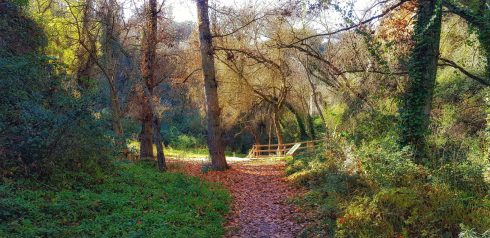IT was on Valentine’s Day four centuries ago that Arriate won its freedom.
On February 14, in 1630, the villagers clubbed together to pay 352,739 Maravedies, the currency back then, in order to buy their independence from Ronda.
An auspicious day, it meant the attractive white village of 5000 souls finally came of age to put itself in charge of its destiny.
Appropriately picking St Valentine as its patron saint, it has celebrated the day with a public holiday ever since.
And now, the town hall is going one step further, rebranding the village as Andalucia’s official ‘Pueblo de Amor’ and encouraging star-crossed lovers from around the world to take a visit.

As well as promoting its romantic mountain backdrop in the heart of the Serrania de Ronda, it is championing its charming local architecture and its original cuisine.
But there is so much more in this beautiful rural escape, just ten minutes from Ronda.
For starters it has its ferias, Semana Santa in particular, which is known throughout Spain for its intensity
Reaching fever pitch on Good Friday, practically every family has a member in one of the two main brotherhoods, despite not being a religious village and staunchly communist or socialist since Franco died in the 1970s.

Such is the competition to be involved, the brotherhoods hold lotteries for the right to carry the tronos (or floats) of Jesus and Mary, who movingly actually meet late on Good Friday.
Other ferias are the Romeria in Spring, the Dia de la Vieja, a day when all the pensioners are taken out to the countryside, and the now famous Fiesta en el Aire, which takes place in October and saw around 40,000 visitors this year.
“It is becoming a key event not just for Arriate, but now for the whole of the Serrania,” explains mayor Javier Anet, a photographer by trade. “The revenue it brings in over three days is extraordinary and all the hotels that weekend in Ronda are now full too.”
A keen environmentalist, having studied Geography at university, he is also heavily involved in the drive to promote the village’s amazing green spaces.

Seeing the huge opportunity of being located next to the recently created Sierra de las Nieves National Park, he is planning a series of circular walks around the village for 2024.
The best will be a four kilometre trip into the land that time forgot, a stunning hidden valley, called the Arroyo de la Ventilla, that literally begins in the centre of Arriate.
The walk into the little-known gorge – a mini version of Ronda’s but much less visited – is crammed full of flora and fauna, including orchids, eagles and even wild animals including genets and stoats.
Even more interesting are the cave houses carved into the vertical sandstone cliffs and other evidence of man that goes back way before the Romans.

“It’s a breathtaking space and a real adventure for anyone looking for a genuine escape,” he explains. “It’s this natural way of life we want to promote to anyone thinking of visiting the area.”
In the heart of the village you’ll want to visit the local church and, in particular, one of the various ham factories that are in some cases centuries old.
One of these in the charming pedestrianised Calle Callejuela has been open as a shop since 1900, a fact proven by the number carved into its pretty wrought iron doorway.
The best ham (and cheese) by far however, is that made by Melgar in the village.
This family-run business is already 90 years old and it has a well-run shop tucked away in the heart of the village, not to mention various shops in Ronda.

One place you certainly mustn’t miss is the converted cinema of Los Caireles restaurant and bar on the high street.
There are few surprises as cool as walking through the easy-to-miss wooden door into this wonderful space that still has much of its original memorabilia still in situ and on the walls.
Run by brothers Monolo and Roberto Rivera, its a lovely conversion of the 1940s Cine Ideal, that is somehow still intact out back.
People came for miles around despite the movies being heavily censored by the local priest and mayor, who would watch the film first demanding cuts.
It shut in 1988 due to dwindling audiences and firstly became a flamenco venue, before becoming a bar and restaurant, with the brothers fighting off offers to turn it into a supermarket or a block of flats. “This is our legacy and part of our town’s key history,” says Roberto. “I grew up watching Cinema Paradiso and always dreamt of one day opening the cinema up again. One day we hope to be able to find the funding to do that.”
For dining, consistently one of the most highly rated eateries in the Serrania is El Muelle, just on the outskirts of town.
Remarkably this was Spain’s Number One restaurant on TripAdvisor for many years and it is run by the well-travelled Dutchman Frank Rottgering, who has created – appropriately – an extremely romantic spot out of a converted 100-year-old railway building.
It’s perfect for romantic couples, particularly as the sun sets on the terrace on warm summer evenings, but equally by candlelight and a warm fire in winter.


